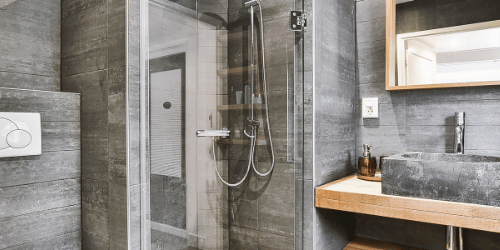Creating an accessible bathroom is essential for ensuring safety, comfort, and independence for individuals with mobility challenges or disabilities. Whether you’re planning for aging in place or accommodating a loved one, thoughtful design and modifications can make a significant difference. In this blog post, we’ll explore various design tips and modifications to make your bathroom more accessible, enhancing its functionality and usability.
Designing an accessible bathroom involves incorporating features such as grab bars, non-slip flooring, and wider doorways to ensure safety and ease of use for individuals with mobility challenges.
Assessing Accessibility Needs
Understanding User Requirements
Identify specific needs based on individual mobility and physical limitations to create a bathroom that caters to current abilities. Consider potential future changes in mobility and plan for adaptable features, such as adjustable fixtures and flexible layouts, to accommodate evolving needs. Consult healthcare providers or occupational therapists for personalized recommendations, ensuring that the bathroom design aligns with the user’s unique requirements and provides maximum safety, comfort, and independence over time.
Evaluating Current Bathroom Layout
Measure the space to ensure there is sufficient clearance for wheelchairs or walkers, allowing for smooth and safe navigation throughout the bathroom. Identify potential hazards, such as uneven surfaces or inadequate lighting, that could pose risks to users with mobility challenges. Plan for necessary structural changes, such as widening doorways or adjusting floor levels, to improve overall accessibility and create a more accommodating environment. These careful considerations help to prevent accidents and ensure that the bathroom is functional and comfortable for everyone.
Setting Priorities for Modifications
Determine which modifications are most critical for safety and comfort to address the most pressing needs first. Balance budget constraints with the necessity of essential features, ensuring that the most important changes are implemented without compromising overall project goals. Prioritize changes that offer the greatest impact on accessibility, such as installing grab bars, adjusting fixtures, or improving lighting, to maximize the benefits and effectiveness of the remodel. By focusing on these key areas, you can create a safer and more functional space while staying within budget.
Enhancing Safety Features
Installing Grab Bars and Handrails
Place grab bars near the toilet, shower, and bathtub to provide essential support and stability for users. Ensure that the bars are securely anchored to the wall studs or other structural supports to withstand weight and pressure, preventing accidents and enhancing safety. Choose grab bars with non-slip surfaces for a better grip, even when wet, to further reduce the risk of slips and falls. These safety features are crucial in creating an accessible and secure bathroom environment, promoting independence and confidence for all users.
Choosing Non-Slip Flooring
Opt for textured tiles or non-slip coatings on bathroom floors to prevent falls, especially in wet areas. Consider using vinyl or luxury vinyl planks, which offer a softer, slip-resistant surface that can help reduce the risk of slipping. Additionally, use non-slip mats or rugs in areas prone to water exposure, such as near the shower, bathtub, and sink, for added safety and peace of mind. These choices enhance the overall safety and comfort of the bathroom, providing a secure environment for all users.
Improving Lighting
Install bright, even lighting throughout the bathroom to enhance visibility and reduce the risk of accidents, ensuring all areas are well-illuminated. Use motion-sensor lights for convenience and energy efficiency, automatically activating when someone enters the room and turning off when the room is unoccupied. Ensure that light switches are easily accessible from a seated position, making it convenient for all users, including those with mobility challenges. These lighting considerations not only improve safety and functionality but also enhance the overall user experience in the bathroom.
Modifying Shower and Bathtub Areas
Creating a Roll-In Shower
Design a barrier-free shower with a low or no threshold to provide easy entry and exit, enhancing accessibility for all users, including those with mobility aids. Include a built-in bench or fold-down seat to offer a comfortable option for seated showering, catering to individuals who may need to sit while bathing. Install handheld showerheads for greater flexibility and ease of use, allowing users to direct water where needed and making showering more convenient for everyone. These features contribute to a safe, functional, and inclusive shower space that accommodates a variety of needs and preferences.
Installing a Walk-In Bathtub
Choose a walk-in tub with a low step-in height and a secure door to ensure safe and easy access, particularly for individuals with limited mobility. Look for models that include built-in seating and grab bars, providing stability and comfort while bathing. Consider additional features like whirlpool jets for therapeutic benefits, offering a relaxing and soothing experience that can help relieve muscle tension and improve circulation. These thoughtful choices enhance the safety, comfort, and overall bathing experience, making the bathroom more accessible and enjoyable for everyone.
Adding Shower Seats and Benches
Provide a stable and comfortable seating option in the shower to accommodate users who may need to sit while bathing. Ensure that the seats are securely mounted to the wall or floor, capable of supporting the user’s weight safely and reliably. Use materials that are resistant to water and mold, such as treated wood, plastic, or stainless steel, to ensure durability and hygiene. These considerations help create a safe and comfortable shower environment, catering to the needs of individuals with mobility challenges and enhancing the overall functionality and accessibility of the bathroom.
Adapting Sinks and Vanities
Choosing Accessible Sink Designs
Opt for wall-mounted sinks to enhance accessibility, particularly for individuals using wheelchairs, as they provide ample space underneath for easy maneuvering. Ensure there is sufficient knee clearance beneath the sink to accommodate comfortable use and to comply with accessibility standards. Additionally, install lever-handled faucets, which are easier to operate than traditional knob handles, allowing for more effortless control, especially for those with limited hand strength or dexterity. These thoughtful design choices create a more inclusive and functional bathroom environment, making it easier for everyone to use the space comfortably and independently.
Modifying Vanity Cabinets
Use open shelving or pull-out drawers to provide easy access to toiletries and other essentials, making it convenient for users to find and reach items without difficulty. Ensure that cabinet handles are positioned within reach from a seated position, allowing for effortless opening and closing, especially for those with mobility challenges. Additionally, consider installing adjustable-height vanities, which offer flexibility to accommodate various needs and preferences, providing a comfortable and accessible solution for everyone. These thoughtful features contribute to a user-friendly and adaptable bathroom space, promoting independence and convenience for all users.
Incorporating Mirrors and Lighting
Install tilt mirrors to accommodate different heights, allowing users to adjust the angle for the best view, whether standing or seated. Use backlit mirrors to provide better illumination, enhancing visibility and adding a modern touch to the bathroom. Ensure that mirrors are positioned at a height accessible to all users, making it easy for everyone, including children and individuals in wheelchairs, to use them comfortably. These considerations help create a bathroom environment that is both practical and inclusive, catering to the diverse needs of all occupants.
Answering Common Questions
Q1 What are the key features of an accessible bathroom?
A1 Key features include grab bars, non-slip flooring, wider doorways, and accessible fixtures like sinks and toilets.
Q2 How can I make my bathroom safer for elderly family members?
A2 Install grab bars, use non-slip flooring, improve lighting, and consider features like walk-in tubs and elevated toilets.
Q3 What modifications are necessary for wheelchair accessibility?
A3 Ensure sufficient clearance space, install roll-in showers, use wall-mounted sinks, and widen doorways.
The Impact of Aging in Place
Aging in place emphasizes the importance of creating a home environment that adapts to the changing needs of its occupants. Accessible bathroom modifications play a crucial role in allowing individuals to maintain their independence and safety as they age.
Seeking Expert Advice
For personalized recommendations and professional installation of accessible bathroom features, consider consulting with experts in home remodeling and accessibility design. They can provide valuable insights and ensure that your bathroom meets all necessary safety and accessibility standards.
Conclusion
Creating an accessible bathroom is a thoughtful and essential step towards ensuring safety, comfort, and independence for individuals with mobility challenges. By incorporating features such as grab bars, non-slip flooring, wider doorways, and accessible fixtures, you can transform your bathroom into a space that meets the needs of all users. Whether you’re planning for aging in place or accommodating a loved one, these design tips and modifications will enhance the functionality and usability of your bathroom, providing peace of mind and improving quality of life. For personalized recommendations and professional installation, consider consulting with experts in home remodeling and accessibility design.
Visit us at Pristine Luxury Remodeling
For more information and personalized guidance visit us at Pristine Luxury Remodeling, We specialize in providing exceptional remodeling services that elevate your space into a masterpiece of luxury.







